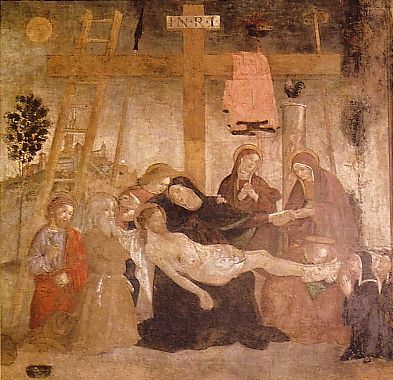

The blessed Virgin Mary has the dead Jesus on her lap lamenting her great loss. Saint John tries to console her. The old man supporting the head of Jesus may be Joseph of Arimathaea or Saint Benedict, while the identity of the man behind him remains obscure. The women to the right are "the Three Marys", i.e. Mary Magdalen, Mary, the mother of James, and Mary Salome. Mary Magdalen, who sometimes is identified with the sinful woman in Luke 7:37-50 or the adulteress mentioned in John 8:3-11, is kissing the feet of Jesus. The small female figures at the extreme right are Benedictine nuns in adoration. The Cross behind the persons in the foreground is surrounded by the instruments of the Passion. From left to right we can see the ladder, the lance, the seamless tunic of Christ for which lots were cast, an unidentified object, the pillar of the scourging with the rooster of Peter's denial on top and the stick of hyssop with the sponge with vinegar. The aforementioned man at the extreme left is holding a tool which resembles a pair of pincers, which also are an instrument of the Passion.